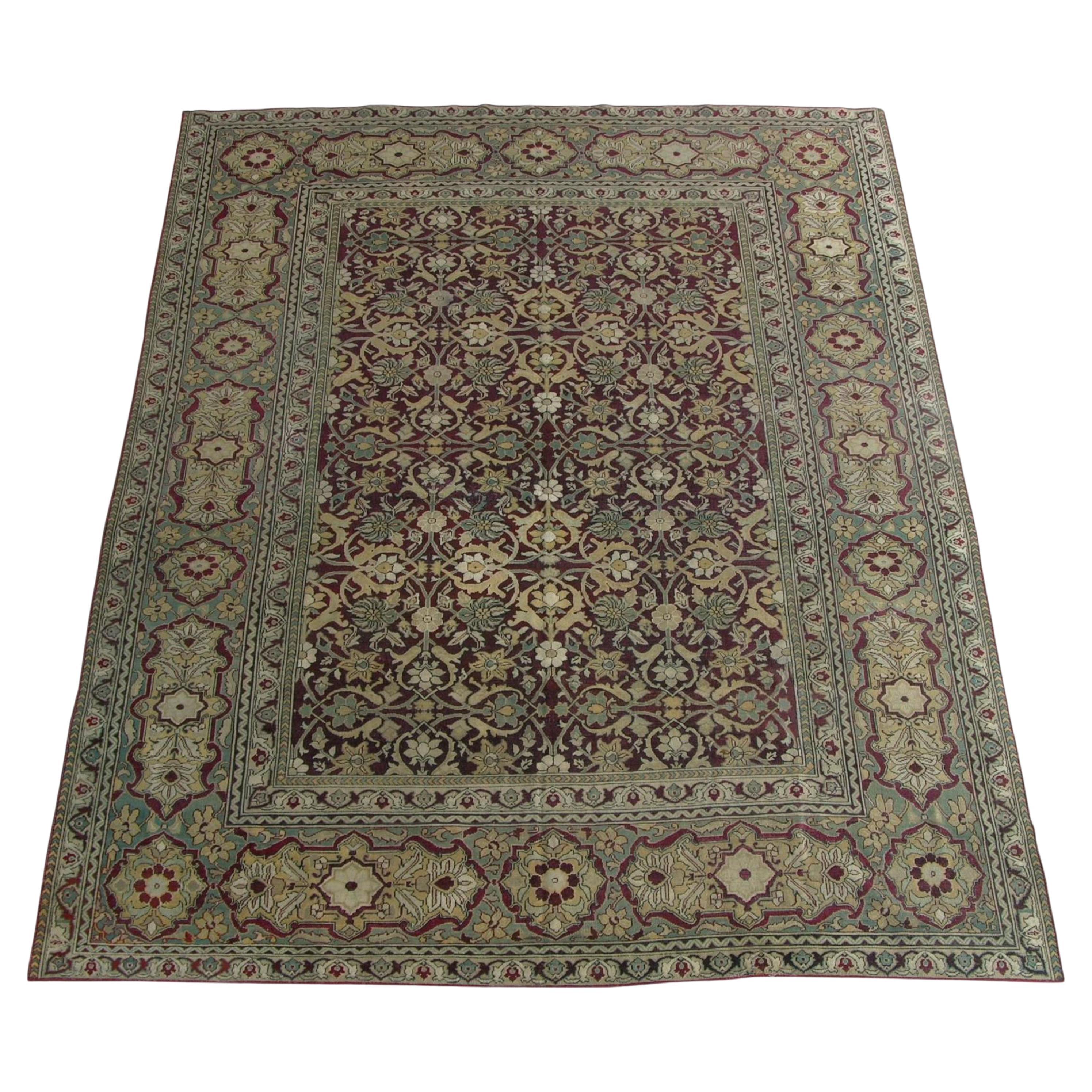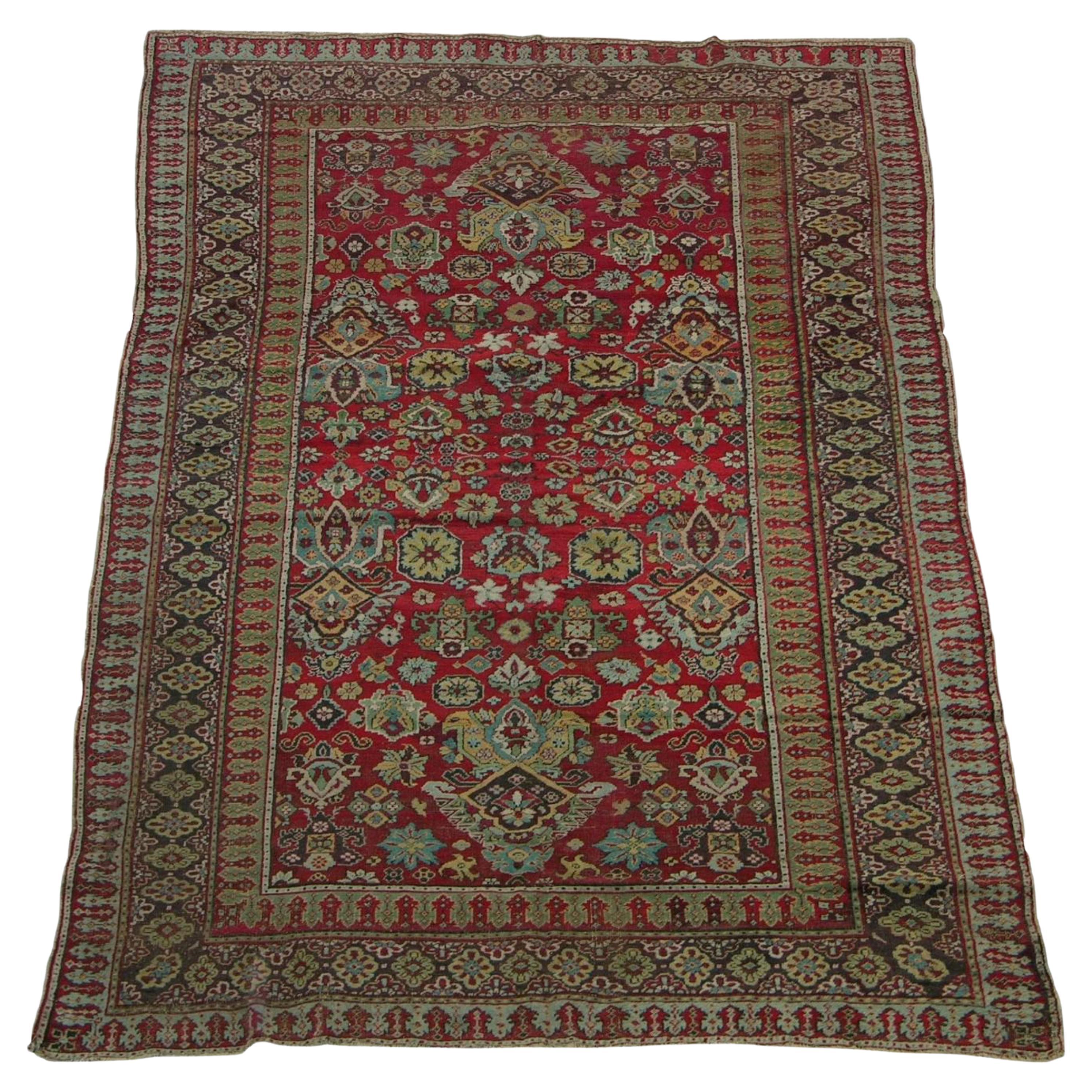Items Similar to 1900s Fine Antique Prayer Turkish Silk Rug - 5'5'' X 3'10''
Want more images or videos?
Request additional images or videos from the seller
1 of 5
1900s Fine Antique Prayer Turkish Silk Rug - 5'5'' X 3'10''
About the Item
Silk Rugs – Silk Carpets and area rugs are the most luxurious productions of their kind. The silk textile production began in China, although silk rugs are unattested there until the seventeenth century.
Silk textile manufacture was well established in Persia by the Sassanian Period (third to seventh centuries). Consequently, it would have been possible for the Persians of this period or those of Early Islamic times to have adapted silk to rug production. But it is so far unclear whether China or the Islamic Orient initiated the manufacture of silk carpets.
At any rate, the earliest extant of all the antique handmade silk rugs are in fact the handmade Persian silk rugs of the Safavid Period. Eventually rugs with all or part silk construction came to be made in virtually all Oriental rug – producing regions – Persia, Turkey, Turkestan, Tibet, and China. In the finest examples, not only the pile but even the foundation (wefts and warp fringes) are made of silk. Silk rugs are luxurious not only because of the fine texture and the reflective, luminous properties of the pile, but also because of the quality of their color. Silk allows the dyes to achieve a richness and intensity that can never be matched by even the finest wool.
Silk is a magical fiber that is unbelievably thin and astoundingly strong. Even when silk highlights are used to add definition to ornate designs, the complexion of a carpet or textile can change completely. The hand of silk rugs and textiles is rich and sumptuous. These traits are matched by the luminosity of colors when light is reflected by the fiber’s prismatic structure. Silk is lithe yet exceptionally durable. As a commodity, it built the world’s most famous trade route and created immortal legends. Today, silk is still the ultimate luxury fiber. The intrinsic value and beauty of silk is destined to outshine all other natural and synthetic fibers known to man.
- Dimensions:Width: 46 in (116.84 cm)Length: 65 in (165.1 cm)
- Style:Other (In the Style Of)
- Materials and Techniques:
- Place of Origin:
- Period:1900-1909
- Date of Manufacture:1900
- Condition:good condition.
- Seller Location:Los Angeles, US
- Reference Number:
About the Seller
5.0
Gold Seller
These expertly vetted sellers are highly rated and consistently exceed customer expectations.
Established in 1920
1stDibs seller since 2023
28 sales on 1stDibs
Typical response time: <1 hour
- ShippingRetrieving quote...Ships From: Los Angeles, US
- Return PolicyA return for this item may be initiated within 3 days of delivery.
More From This SellerView All
- 1900s Antique Fine Indian Purple Amritsar RugLocated in Los Angeles, USAntique Amritsar Rugs – The spectacular rugs of Amritsar capture the exotic style of India while incorporating a subtle colonial influence. This convergence of eastern and western st...Category
Antique Early 1900s Asian Other Russian and Scandinavian Rugs
MaterialsWool, Cotton
- 1900s Fine Antique Caucasian Karabagh RugLocated in Los Angeles, USAntique Karabagh rugs Eagerly sought after by collectors as well as designers, have one of the oldest and most varied design traditions of any antique Caucasian rugs. Many are descen...Category
Antique Early 1900s Asian Tribal Russian and Scandinavian Rugs
MaterialsWool, Cotton
- Antique Samarkand Rug 1900 -8'6'' X 5'5''Located in Los Angeles, USAntique Uzbek Samarkand Rug 8'6'' X 5'5'', tribal and traditional, antique and vintage, wool on cotton foundationCategory
Antique Early 1900s Uzbek Tribal Russian and Scandinavian Rugs
MaterialsWool, Cotton
- 1900s Antique Indian Amritsar RugLocated in Los Angeles, USAntique Amritsar Rugs – The spectacular rugs of Amritsar capture the exotic style of India while incorporating a subtle colonial influence. This convergence of eastern and western styles results in an exceptionally alluring appearance that has been beloved by western consumers historically and today. The outstanding old Amritsar carpets were created by influential exporters to fuel the demand for exotic rugs...Category
Antique Early 1900s Asian Other Russian and Scandinavian Rugs
MaterialsWool, Cotton
- 1900s Antique French Needlepoint RugLocated in Los Angeles, USNeedlepoint rugs were created using the traditional needlework weaving technique that is used to make everyday items from furniture to carpets and artwork. However, it has a fascinating history both as a hobby and as an industry. When many people think of carpets, they think of pile carpets or flat weave kilims, but needlepoint has also been used to create beautiful carpets. These carpets are durable and an important part of carpet history. Archaeologists and scholars consider the roots of needlepoint to have been around 1500 BC. They consider the first needlepoint to include the fine diagonal stitches that were used to sew tents together by the ancient Egyptians. The art eventually evolved into tapestry weaving. However, a tapestry weaving differs significantly from needlepoint in that it uses a loom and vertical warp. Tapestry weaving is closer to the weaving of kilims and pile rugs than canvas work. However, some still include tapestry weaving in the category of needlepoint because of the fine work that appeared during the late Renaissance. It can have a similar appearance to the untrained eye. Technically, tapestry weaving and needlepoint are not the same, and they do not use the same technique. The first actual needlepoint rugs and needle-points began to appear in the late Renaissance. Needlepoint is worked by creating stitches on a stiff canvas. The canvas is typically made from jute or linen and is quite durable. Pieces from the Renaissance were used to cover footstools, chairs, pillows, bed headboards, and other furnishings. They were also used as table coverings and wall coverings. You could also find them on many small items such as purses, shoes, and various adornments for clothing. During the Renaissance, the craft reached a high level of skill, and the designs became incredibly detailed and realistic. They mimicked many of the subjects and styles of famous paintings of the time. They created florals, still life designs, scenes, and geometric tiled pieces. Some of them mimicked the designs found in Persian Carpets. Needlepoint reached its peak popularity in the 19th century when it was considered a proper occupation for a lady. Needlepoint and embroidery held a similar place in societal status at the time. During this time, the work became finer, with some of the canvas reaching a high level of detail. The level of detail is determined by counting the number of mesh in an inch. During this time petit point by French needlewomen could have a mesh count as high as 45 mesh. This allowed women to create highly intricate designs with incredible levels of detail. It is possible to find many antique pieces of needlepoint besides rugs. Needlepoint rugs were popular in France and Spain, where the technique was adapted to create highly intricate designs that mimicked the designs in architecture and fashion. They were popular because they were durable, and it could be fashioned into a variety of items. The canvases themselves were durable, and the wool that they used was also strong, which means that many of the pieces were able to withstand daily use. We have many artifacts that have survived from this time period. Needlepoint rugs are important collectibles because they are different from the pile rugs and kilims that are typically found on the market. Needlepoint carpets are special because they take many hours to create, especially larger works. Needlepoint pieces of any type became popular throughout Europe during the 19th century. It is still a popular hobby today, but perhaps one of the most interesting stories is that of the Portuguese needlewomen of Arraiolos. The story of these women and their beautiful carpets begins in 1492. Needlepoint was a popular occupation in Spain, which had a large population of Moors and Jews. They were an integral part of Spanish culture. However, in 1492, Queen Isabella of Spain issued a proclamation that gave these ethnic groups the order to pack their bags and board ships headed...Category
Antique Early 1900s Other Russian and Scandinavian Rugs
MaterialsWool, Cotton
- 1900s Antique Indian Amritsar RugLocated in Los Angeles, USAntique Amritsar Rugs: - The spectacular rugs of Amritsar capture the exotic style of India while incorporating a subtle colonial influence. This convergence of eastern and western s...Category
Antique Early 1900s Asian Other Russian and Scandinavian Rugs
MaterialsWool, Cotton
You May Also Like
- Antique Zeikor Rug 4'0" x 5'5''Located in New York, NYAntique Zeikor Rug 4'0" x 5'5''. Although we have ascribed it to Zeychur village in the NE Caucasus, it is more likely a scatter-format Kuba from another town. The sand field display...Category
Antique Early 1900s Russian and Scandinavian Rugs
MaterialsWool
- Handmade Antique Caucasian Avar Rug, 1900s, 1p49Located in Bordeaux, FRHandmade antique Caucasian Avar rug from Daghetsan. The rug is in unusual design, from the beginning of 20th century. -condition: good, -circa: 1900s, ...Category
Antique Early 1900s Russian Russian and Scandinavian Rugs
MaterialsWool
- Antique Hand Woven Russian Besserabian Rug, circa 1900sLocated in New York, NYThis southern Russian kilim-tapestry technique carpet shows a golden-tan field with a three echelon pattern of outline cartouches and barbed leaf-forms detailed in sienna, cream and ...Category
Antique Early 1900s Russian Bessarabian Russian and Scandinavian Rugs
MaterialsWool
- Antique Russian Chichi, circa 1900sLocated in WEST HOLLYWOOD, CARug Number 17218 Size 3' 5" X 6' 2" Design Chichi Collection Antique/Vintage Material Wool Texture Pile Weave Origin Russia Age Antique/Vintage.Category
Antique Early 1900s Russian Russian and Scandinavian Rugs
MaterialsWool
- Antique Russian Gharabagh Circa 1900sLocated in WEST HOLLYWOOD, CARug Number 28430 Size 3' 8" X 5' 7" Design Gharabagh Collection Antique/Vintage Material Wool Texture Pile Weave Origin Russia Age Antique/VintageCategory
Antique Early 1900s Russian Russian and Scandinavian Rugs
MaterialsWool
- Turkish Rug Antique, c. 1900sLocated in Los Angeles, CAThis Turkish antique rug has a distinctive and almost playful pattern. The two main shapes are hand-drawn-like and not perfectly symmetrical adding to the rug's unique quality. Its p...Category
20th Century Central Asian Rugs
MaterialsWool





